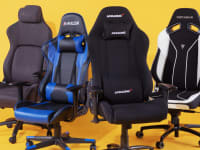 Credit:
Reviewed / John Higgins
Credit:
Reviewed / John Higgins
Recommendations are independently chosen by Reviewed's editors. Purchases made through the links below may earn us and our publishing partners a commission.
Comparing two wireless multiroom audio speakers from separate ecosystems, like the Sonos Era 300 and Bluesound Pulse M, may seem like folly. After all, if you’re already locked into a whole home’s worth of Sonos speakers, are you likely to jump ship to BluOS, or vice versa? Perhaps not. But that’s not to say that the comparison is completely without merit. After all, you may be looking at the latest upper-end speakers in both lineups as a benchmark to decide whether you’d like to buy into Sonos or Bluesound to begin with.
The Sonos Era 300 and Bluesound Pulse M don’t make that choice an easy one. Each takes a decidedly distinctive approach to the notion of what a high-end wireless multiroom tabletop speaker should be, how it should behave, what it should sound like, and how you should interact with it. One relies on native Atmos capabilities to fill the room with sound in three dimensions. The other focuses on expansive stereo sound done well, but also adds an element of elevated luxury with its stylish design and novel motion-sensing illuminated controls. Which one is right for you—again, assuming you’re not already a dedicated Sonos or BluOS fan—is largely dependent upon whether one speaker or the other’s design philosophy and approach to sound reproduction better jibes with yours. Having reviewed them both, we’re here to help make the decision a little easier by comparing them in terms of price, design, features and interface, and of course sound quality.
Price
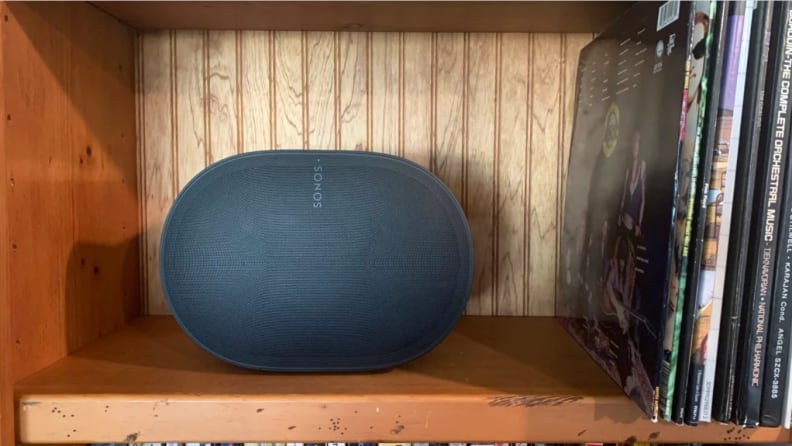
The Sonos justifies its slightly higher price with hardware that helps to decode Dolby Atmos sound.
The Bluesound Pulse M sells for $399, whereas the Sonos Era 300 costs $50 more at $449. On the one hand, the Era 300 justifies its higher price with its six drivers—two side-firing woofers, two side-firing mid-tweeters, a horn-loaded up-firing tweeter, and a front-firing tweeter with a waveguide to control dispersion and enhance efficiency. The hardware required to natively decode Dolby Atmos audio from Amazon Music and Apple Music also certainly adds to the manufacturing costs.
The Pulse M, meanwhile, has a single woofer and two angled tweeters. That may seem to give the Era 300 the edge in terms of value, even if not in terms of pure bottom line. But the Pulse M also has a few enhancements that justify its price. The touch-sensitive controls that appear out of nowhere as your hand approaches the top of the speaker contribute to a sort of Bang & Olufsen-like user experience, and the fit and finish are top notch. So, despite the disparity in price, both speakers seem on pretty even footing in terms of bang for the buck.
Our pick: Draw
Design
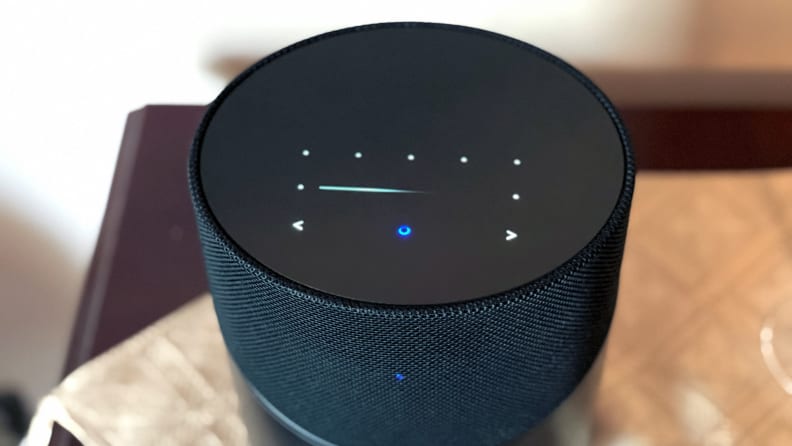
Among the Bluesound Pulse M's many design flourishes are motion-activated touch controls that light up as your hand approaches.
The design of the Sonos Era 300 was best described by our own Managing Editor John Higgins as “cinched.” That’s a matter of form following function, as the distinctive driver configuration projects sound not only out into the room, but also to the sides and upward. It certainly stands out, and the capacitive touch controls are easy to spot and easy to use. But it’s still not likely to be the centerpiece of your room’s décor.
The Pulse M, on the other hand, may look at first glance remarkably similar to the Sonos Move 2 portable speaker, what with its squashed cylindrical cabinet. But closer inspection reveals more subtle design cues that elevate the speaker’s zhuzh: the curved bevels on the bottom of the speaker, the angled dividing line between grille and cabinet, and most importantly, the motion-sensing capacitive touch controls, which light up as your hand approaches the top of the speaker. You may not be in the habit of using the physical controls on your wireless multiroom speakers, but the Pulse M will challenge you in that regard. It’s a speaker that begs to be touched.
Our pick: Pulse M
Features and interface

The BluOS is a sleek, reliable, and easily navigable interface that's hard to beat.
The Sonos app is nearly universally considered to be easy to set up and easy to use, and indeed, we’ve found it to be far more intuitive than much of its competition. The universal search function is exceedingly helpful, especially given how many streaming services Sonos supports. It is the undisputed king in that regard.
That said, we find BluOS—the operating system built into Bluesound speakers, along with streaming-capable hi-fi products from sister brand NAD, along with a few others—to be easier to set up, easier to navigate, more reliable, more stable, and requiring fewer reboots (zero, in several months of use, in fact). It may not support quite as many streaming services as Sonos, but it almost certainly integrates the one you use most.
Bluesound recently announced a major overhaul of its platform, and we’d be lying if we said that didn’t make us nervous. The new v4.0 app reportedly benefits from improved navigation, better customization, centralized integration of streaming services and external sources, and better/faster search capabilities. The real question is whether or not it will diminish the intuitiveness of the app. We’ll have to wait and see, but for now, we think BluOS is a much better app and platform than Sonos.
Our pick: Pulse M
Performance

While both speakers perform, one undeniable fact is that the Sonos Era 300 fills larger rooms better.
This is hardly an apples-to-apples comparison, because while both speakers perform quite well, the Era 300 does things that the Pulse M simply cannot: namely, it legitimately decodes Dolby Atmos music streamed from Amazon and Apple, and fills the room with sound that radiates upward, outward, and toward the listener.
The Pulse M, meanwhile, has a single woofer and a pair of tweeters that are angled outward at 45 degrees, giving you something of a stereo effect even if you’re on the other side of a mid-sized room.
The Sonos also benefits from room-correction technology called TruePlay, which reverses some of the damage done to the sound by the room itself, smoothing out the mid and upper frequencies and enhancing bass without allowing it to become bloated.
There’s simply no denying that the Era 300 can also play more loudly in larger rooms. Oddly enough, though, even despite its TruePlay tuning, it’s a bit more sensitive to placement in the room. Get it too close to a wall on one side or the other, and the soundfield gets lopsided way more prominently than does the Pulse M. The tonal balance of the music also changes more drastically if it’s closer to one side wall than the other, or if it’s placed too near a corner.
Place both speakers in reasonably appropriate spots, though, and they both sound excellent. The Era 300 is—both by default and after TruePlay tuning—a bit more bass-heavy, which gives the subjective impression of less treble and as a result less detail. The Pulse M, meanwhile, has slightly recessed midrange frequencies, not wholly dissimilar to beloved audiophile speakers like the classic BBC LS3/5A, and slightly more perceptual detail thanks to a bit more energy in the higher frequencies.
Our pick: Draw
And the winner is ...
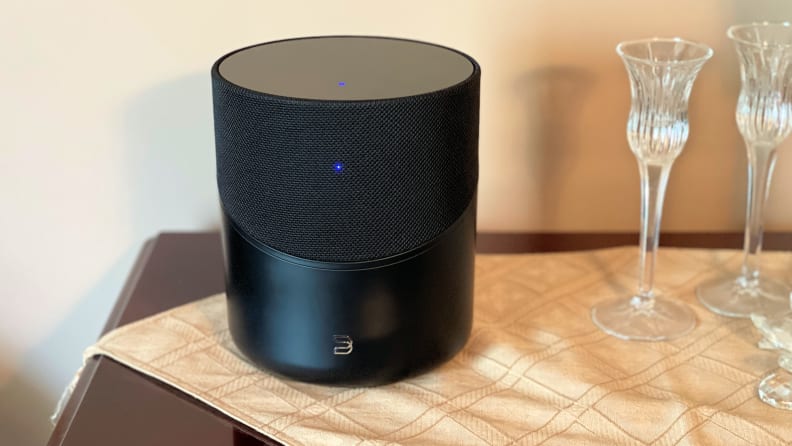
While the Bluesound Pulse M takes more categories in our assessment, both speakers are fantastic and shine in different areas.
With two clear wins for the Bluesound Pulse M and two draws, it might seem the obvious winner in this showdown. But reality on the ground isn’t quite so simple. Ultimately, both speakers are excellent, and it’s really going to come down to what you’re looking for in a wireless speaker. Again, that’s assuming you don’t already have a strong preference for BluOS or Sonos.
If you’re an audiophile who’s keen to build a multiroom audio system that also includes traditional hi-fi components such as an integrated amplifier with speakers attached, BluOS is probably the better choice for you. The Pulse M is also a more attractive speaker, and the wow-factor of its hand-sensing touch illuminated touch controls hasn’t worn off a bit in the months we’ve lived with the speaker.
On the other hand, the Sonos Era 300 gives you legitimate Atmos sound from one cabinet, and it plays better in larger rooms that the Pulse M struggles to fill with stereo sound.
If you’re still undecided or if none of these criteria really sway you, the BluOS platform is easier to set up and use on a day-to-day basis, so perhaps that might be the determining factor. The reality is, there’s no bad choice here, though.
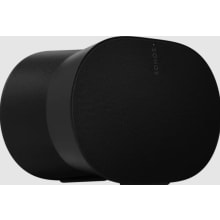
The Sonos Era 300 promises incredible spatial audio performance from a single compact speaker and it absolutely delivers.
Buy the Era 300 at Sonos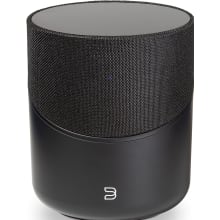
The Bluesound Pulse M provides full and neutral stereo sound from practically anywhere in the room.
Buy the Pulse M at Amazon
